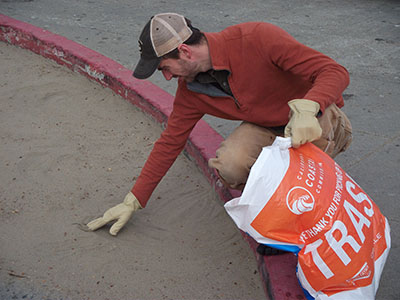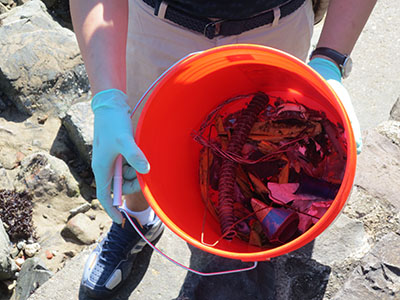This year marks the 30th anniversary of the stateís biggest volunteer event, California Coastal Cleanup Day. More than just picking up trash, this event offers a chance for Californians to unite and express their respect for clean water and healthy marine life.

California Coastal Cleanup Day on September 20 is the stateís biggest volunteer event, with over 58,000 people participating last year. Photo courtesy of Aquarium of the Bay
By Brittany Silveira
Published: September, 2014
This year marks the 30th anniversary of the state’s biggest volunteer event, California Coastal Cleanup Day. More than just picking up trash, this event offers a chance for Californians to unite and express their respect for clean water and healthy marine life. In 2013, over 58,000 volunteers removed almost 750,000 pounds of trash and recyclables from California’s coasts. This year, on September 20, volunteers will come together again from all over the state to to help preserve our beaches.
Marine debris can be harmful or fatal to wildlife, and can also become a human health hazard. The majority of trash items found in the ocean are plastics that come from land. Trash travels via wind, rainwater or rivers and ends up on the coast. From there it enters the ocean, and when it does, animals can become entangled in it or ingest it. For example, sea turtles often mistake plastic bags for jellyfish, and when turtles eat plastic bags, they may die from choking or starvation. Animals also become fatally entangled in items like fishing line.
Coastal debris harms humans as well. Nails, glass and syringes found on the beach can cause physical harm to those who visit. Additionally, trash in our waterways increases the amount of pathogens and chemicals in our water. Plastic residue may also find its way into the food supply through marine life that eats plastic items and then is consumed by humans as food. Beach cleanups are our last line of defense to prevent further harm to ourselves, our oceans and marine life.
For over 10 years, Aquarium of the Bay has contributed to Coastal Cleanup Day by hosting a cleanup at Aquatic Park near Fisherman’s Wharf. In addition to cleaning up the shoreline, Aquarium of the Bay divers take it one step further and go underwater to remove trash that has settled in the Bay. Some of the items found by our divers can even be found in the Aquarium’s Trash Talk exhibit, which shows visitors what happens to our trash that ends up in the Bay.
If you’re interested in getting involved this year, join Aquarium of the Bay at Aquatic Park near Fisherman’s Wharf. Together we can stop trash before it enters or re-enters the ocean, and we can live with a cleaner, healthier ecosystem. To find out more about how you can participate, visit www.aquariumofthebay.org.
Below are the top 13 trash “species” on our coast and shorelines:
• Cigarette butts
• Plastic bags
• Fishing gear
• Plastic utensils and straws
• Styrofoam food containers and cups
• Metal bottle caps
• Aluminum cans
• Pieces of rubber tires
• Plastic water bottles
• Gum
• Six-pack ring holders
• Glass bottles
• Coffee cup lids and stoppers
Brittany Silveira is a University of San Francisco student currently studying communications and interning with Aquarium of the Bay.

Photo courtesy of Aquarium of the Bay

